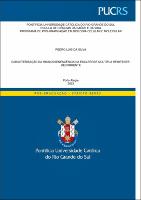| Share record |


|
Please use this identifier to cite or link to this item:
https://tede2.pucrs.br/tede2/handle/tede/11235| Document type: | Dissertação |
| Title: | Caracterização da imunossenescência na esclerose múltipla remitente-recorrente |
| Author: | Silva, Pedro Luis da |
| Advisor: | Bauer, Moisés Evandro |
| Abstract (native): | A esclerose múltipla (EM) é uma doença inflamatória crônica e desmielinizante do sistema nervoso central. A fisiopatologia da EM resulta de interações complexas entre células T autorreativas e células B que levam a inflamação e desmielinização no sistema nervoso central (SNC). As taxas de envelhecimento (ou trajetórias) podem influenciar o adoecimento e mortalidade dos indivíduos. Indivíduos que envelhecem mais rapidamente, como visto na EM, apresentam um envelhecimento do sistema imune (imunossenescência) que pode comprometer a progressão clínica da doença. Um estado de inflamação crônica de baixo grau, que tem sido referido como inflammaging, também pode influenciar quadros clínicos na EM. Nesse trabalho, nós caracterizamos a imunossenescência na EM remitente-recorrente (EMRR) e investigamos sua associação com a progressão clínica. Vinte e dois pacientes com EMRR foram recrutados para avaliação no Serviço de Neurologia do Hospital São Lucas da PUCRS. Foi realizada uma análise abrangente de imunofenotipagem por citometria de fluxo para investigar subgrupos de linfócitos e monócitos, incluindo seu estado de ativação, fase de diferenciação, perfis de regulação, senescência e exaustão. As citocinas envolvidas com inflammaging (IL-1β, IL-8, IL-6 e TNF-α) ou regulação (IL-10) foram quantificadas no soro. O comprimento dos telômeros foi medido por PCR em tempo real, como marcador do envelhecimento biológico. Um total de 21 controles saudáveis e 25 pacientes foram recrutados e emparelhados por idade e sexo. Os pacientes com EMRR tinham linfócitos telômeros menores que os controles. Na avaliação de citocinas, não houve diferença entre os grupos. Os pacientes apresentaram proporções mais baixas de monócitos não clássicos (CD16brightCD14+) e clássicos (CD16-CD14bright), embora proporções aumentadas de monócitos intermediários (CD16+CD14bright) em comparação aos controles (todos p<0,05). Os subconjuntos NK (CD16+CD56dim e CD16lowCD56bright) não diferiram entre os indivíduos. Menores proporções de células B transicionais (fenótipo) e células B reguladoras (fenótipo) foram observadas em RMSS (todos p<0,05). Os pacientes apresentaram proporções menores de células T diferenciadas precocemente (CD27+CD28+), mas nenhuma alteração nas células intermediárias (CD27-CD28+) ou diferenciadas tardiamente ou senescentes (CD27-CD28-). Embora os pacientes apresentassem proporções significativamente menores de células T ativadas (CD25+) tanto nas células CD4+ quanto nas células CD8+ (todas p<0,0001), não foram observadas alterações nas células T reguladoras (CD4+FoxP3+). Em relação aos checkpoints, os pacientes apresentaram proporções aumentadas de células CD4+PD-1+ em comparação aos controles (p<0,01), mas menores percentuais de células CD8+CTLA-4+ (p<0,01). Além disso, foram observadas proporções significativamente mais baixas de células T CD4+ e CD8+ expressando NKG2A ou NKG2D em pacientes (todos p<0,05). Embora a senescência precoce em RMSS tenha sido confirmada por telômeros encurtados e aumento de células T CD4+PD-1+, nenhuma alteração foi relatada em células T mais diferenciadas. |
| Abstract (english): | Multiple sclerosis (MS) is a chronic inflammatory and demyelinating disease of the central nervous system. The pathophysiology of MS results from complex interactions between autoreactive T cells and B cells that lead to inflammation and demyelination in the central nervous system (CNS). Aging rates (or trajectories) can influence individuals' morbidity and mortality rates. Individuals aging more quickly, as seen in MS, have an aging immune system (immunosenescence) that may compromise the clinical progression of the disease. A state of chronic low-grade inflammation, which has been referred to as inflammaging, may also influence clinical pictures in MS. In this work, we further characterized immunosenescence in relapsing-remitting MS (RRMS) and investigated its association with clinical progression. Twenty-two patients with RRMS were recruited for evaluation at the Neurology Service of Hospital São Lucas at PUCRS. A comprehensive flow cytometric multicolor immunophenotyping analysis was performed to investigate subsets of lymphocytes and monocytes, including their activation state, differentiation states, regulatory, senescence, and exhaustion profiles. Cytokines involved in inflammation (IL-1beta, IL-8, IL-6 and TNFalpha) or regulation (IL-10) were quantified in serum. Telomere length was measured by real-time PCR as a marker of biological aging. A total of 21 healthy controls and 25 patients were recruited and matched for age and sex. Patients with RRMS had shortened telomeres in mononuclear cells than controls. Concerning the cytokines, there were no differences between groups. Patients had lower proportions of nonclassical (CD16brightCD14+) and classical (CD16-CD14bright) monocytes, although increased proportions of intermediate monocytes (CD16+CD14bright) compared to controls (all p<0.05). The NK subsets (CD16+CD56dim and CD16lowCD56bright) did not differ between individuals. Lower proportions of transitional B cells (CD19+ CD38HIGH) and regulatory B cells (CD19+CD27+CD38+) were observed in RMSS (all p<0.05). Patients had lower proportions of early-differentiated (CD27+CD28+) T cells, but no change in intermediate (CD27-CD28+) or late-differentiated or senescent (CD27-CD28-) cells. Although patients had significantly lower proportions of activated T cells (CD25+) in both CD4+ and CD8+ cells (all p<0.0001), no changes were observed in regulatory T cells (CD4+FoxP3+). Regarding checkpoint molecules, patients had increased proportions of CD4+PD-1+ cells compared to controls (p<0.01), but lower percentages of CD8+CTLA-4+ cells (p<0.01). In addition, significantly lower proportions of CD4+ and CD8+ T cells expressing NKG2A or NKG2D were observed in patients (all p<0.05). Although early senescence in RMSS was confirmed by shortened telomeres and increased CD4+PD-1+ T cells, no changes were reported in more differentiated T cells. |
| Keywords: | Esclerose Múltipla Inflamação Imunosenescência Células T |
| CNPQ Knowledge Areas: | CIENCIAS BIOLOGICAS::BIOLOGIA GERAL |
| Language: | por |
| Country: | Brasil |
| Publisher: | Pontifícia Universidade Católica do Rio Grande do Sul |
| Institution Acronym: | PUCRS |
| Department: | Escola de Ciências Saúde e da Vida |
| Program: | Programa de Pós-Graduação em Biologia Celular e Molecular |
| Access type: | Acesso Aberto |
| Fulltext access restriction: | Trabalho será publicado como artigo ou livro |
| Time to release fulltext: | 12 meses |
| Date to release fulltext: | 28/05/2025 |
| URI: | https://tede2.pucrs.br/tede2/handle/tede/11235 |
| Issue Date: | 29-Sep-2023 |
| Appears in Collections: | Programa de Pós-Graduação em Biologia Celular e Molecular |
Files in This Item:
| File | Description | Size | Format | |
|---|---|---|---|---|
| DIS_PEDRO_LUIS_DA_SILVA_COMPLETO.pdf | PEDRO_LUIS_DA_SILVA_DIS | 1.31 MB | Adobe PDF |  Download/Open Preview |
Items in DSpace are protected by copyright, with all rights reserved, unless otherwise indicated.




